9 books about Visible
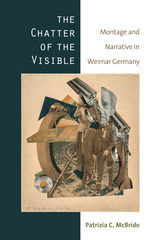
The Chatter of the Visible
Montage and Narrative in Weimar Germany
Patrizia C. McBride
University of Michigan Press, 2016
The Chatter of the Visible examines the paradoxical narrative features of the photomontage aesthetics of artists associated with Dada, Constructivism, and the New Objectivity. While montage strategies have commonly been associated with the purposeful interruption of and challenge to narrative consistency and continuity, McBride offers an historicized reappraisal of 1920s and 1930s German photomontage work to show that its peculiar mimicry was less a rejection of narrative and more an extension or permutation of it—a means for thinking in narrative textures exceeding constraints imposed by “flat” print media (especially the novel and other literary genres).
McBride’s contribution to the conversation around Weimar-era montage is in her situation of the form of the work as a discursive practice in its own right, which affords humans a new way to negotiate temporality, as a particular mode of thinking that productively relates the particular to the universal, or as a culturally specific form of cognition.
[more]

Intermittences
Memory, Justice, and the Poetics of the Visible in Uruguay
Ana Forcinito
University of Pittsburgh Press, 2018
The construction of memory entails a battle not only between memory and forgetting but also between different memories. There are multiple constructions of memory, and in the dispute between them, some become hegemonic, while others remain in the margins. Ana Forcinito explores the intermittences of transitional justice and memory in post-dictatorship Uruguay. The processes of building memory and transitional justice are repetitive but inconstant. They are contested by both internal and external forces and shaped by tensions between oblivion and silence. Forcinito explores models of reconciliation to present an alternative narrative of the past and to expose the blind spots of memory.
[more]
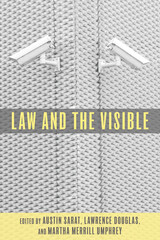
Law and the Visible
Edited by Austin Sarat, Lawrence Douglas, and Martha Merrill Umphrey
University of Massachusetts Press, 2021
If you take a video of police officers beating a Black man into unconsciousness, are you a witness or a bystander? If you livestream your friends dragging the body of an unconscious woman and talking about their plans to violate her, are you an accomplice? Do bodycams and video doorbells tell the truth? Are the ubiquitous technologies of visibility open to interpretation and manipulation? These are just a few of the questions explored in the rich and broadly interdisciplinary essays within this volume, Law and the Visible, the most recent offering in the Amherst Series for Law, Jurisprudence, and Social Thought.
Individual essays discuss the culpability of those who record violence, the history of racialized violence as it streams through police bodycams, the idea of digital images as objective or neutral, the logics of surveillance and transparency, and a defense of anonymity in the digital age.
Contributors include Benjamin J. Goold, Torin Monahan, Kelli Moore, Eden Osucha, Jennifer Peterson, and Carrie A. Rentschler.
Individual essays discuss the culpability of those who record violence, the history of racialized violence as it streams through police bodycams, the idea of digital images as objective or neutral, the logics of surveillance and transparency, and a defense of anonymity in the digital age.
Contributors include Benjamin J. Goold, Torin Monahan, Kelli Moore, Eden Osucha, Jennifer Peterson, and Carrie A. Rentschler.
[more]
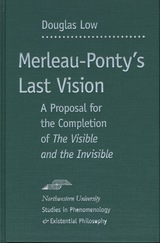
Merleau-Ponty's Last Vision
A Proposal for the Completion of "The Visible and the Invisible"
Douglas Low
Northwestern University Press, 2000
Few writers' unfinished works are considered among their most important, but such is the case with Merleau-Ponty's The Visible and the Invisible. What exists of it is a mere beginning, yet it bridged modernism and postmodernism in philosophy. Low uses material from some of Merleau-Ponty's later works as the basis for completion. Working from this material and the philosopher's own outline, Low presents how this important work would have looked had Merleau-Ponty lived to complete it.
[more]

The New Politics of Visibility
Spaces, Actors, Practices and Technologies in the Visible
Edited by Andrea Mubi Brighenti
Intellect Books, 2022
Nine interdisciplinary essays employ, explore, and critique the analytical category and the practical stakes of visibility.
Not only does visibility matter to politics, but it is an increasingly intrinsic constituent element and a crucial asset of it. Accordingly, the challenge to social science is that of understanding how the new institutional, urban, and technological settings are reshaping the organization of the visible.
Ranging from urban public space to the new media and social media platforms, a team of distinguished scholars and researchers here addresses a vast terrain of inquiry by joining together original theoretical elaboration with careful empirical studies. The result is a thoroughly interdisciplinary endeavor, conducted with passion and insight. The New Politics of Visibility comprises nine original interdisciplinary chapters that analyze topical areas in the newly emerging modes of governance and society. The transformations of urban space and the working of new media form a core concern recurring through many of the essays but is by no means the sole topic, as other essays address the politics of visibility in crucial cultural spheres, including gender relations and professional life.
Not only does visibility matter to politics, but it is an increasingly intrinsic constituent element and a crucial asset of it. Accordingly, the challenge to social science is that of understanding how the new institutional, urban, and technological settings are reshaping the organization of the visible.
Ranging from urban public space to the new media and social media platforms, a team of distinguished scholars and researchers here addresses a vast terrain of inquiry by joining together original theoretical elaboration with careful empirical studies. The result is a thoroughly interdisciplinary endeavor, conducted with passion and insight. The New Politics of Visibility comprises nine original interdisciplinary chapters that analyze topical areas in the newly emerging modes of governance and society. The transformations of urban space and the working of new media form a core concern recurring through many of the essays but is by no means the sole topic, as other essays address the politics of visibility in crucial cultural spheres, including gender relations and professional life.
[more]
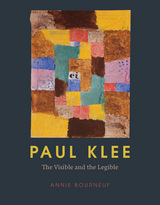
Paul Klee
The Visible and the Legible
Annie Bourneuf
University of Chicago Press, 2015
The fact that Paul Klee (1879–1940) consistently intertwined the visual and the verbal in his art has long fascinated commentators from Walter Benjamin to Michel Foucault. However, the questions it prompts have never been satisfactorily answered—until now. In Paul Klee, Annie Bourneuf offers the first full account of the interplay between the visible and the legible in Klee’s works from the 1910s and 1920s.
Bourneuf argues that Klee joined these elements to invite a manner of viewing that would unfold in time, a process analogous to reading. From his elaborate titles to the small scale he favored to his metaphoric play with materials, Klee created forms that hover between the pictorial and the written. Through his unique approach, he subverted forms of modernist painting that were generally seen to threaten slow, contemplative viewing. Tracing the fraught relations among seeing, reading, and imagining in the early twentieth century, Bourneuf shows how Klee reconceptualized abstraction at a key moment in its development.
Bourneuf argues that Klee joined these elements to invite a manner of viewing that would unfold in time, a process analogous to reading. From his elaborate titles to the small scale he favored to his metaphoric play with materials, Klee created forms that hover between the pictorial and the written. Through his unique approach, he subverted forms of modernist painting that were generally seen to threaten slow, contemplative viewing. Tracing the fraught relations among seeing, reading, and imagining in the early twentieth century, Bourneuf shows how Klee reconceptualized abstraction at a key moment in its development.
[more]
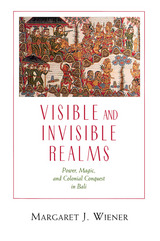
Visible and Invisible Realms
Power, Magic, and Colonial Conquest in Bali
Margaret J. Wiener
University of Chicago Press, 1995
In 1908, the ruler of the Balinese realm of Klungkung and more than 100 members of his family and court were massacred when they marched deliberately into the fire of the Dutch colonial army. The question of what their action meant and its continued significance in contemporary Klungkung forms the basis of Margaret Wiener's complex anthropolological history.
Wiener challenges colonial and academic claims that Klungkung had no "real" power and argues that such claims enabled colonial domination. By focusing on Balinese discourses she makes clear the choices open to Balinese, both at the time of the Dutch conquest and in its narration. At the same time, she shows how these discourses, which revolve around magical weapons acquired from invisible agents such as gods, spirits, and ancestors, offer an alternative understanding of Klungkung's power.
Moving between Balinese and Dutch narratives and between past and present, Wiener critiques colonial accounts by recounting Balinese memories and interpretations. Her attention to history and local situations illuminates the ways in which colonialism and orientalist scholarship have obscured the power of indigenous rulers and shows how Klungkung, once Bali's paramount realm, was relegated to a peripheral corner of the Indonesian nation-state. Both as a fascinating story and as a rich example of interdisciplinary scholarship, this book will interest students of colonialism, anthropology, history, religion, and Southeast Asia.
Wiener challenges colonial and academic claims that Klungkung had no "real" power and argues that such claims enabled colonial domination. By focusing on Balinese discourses she makes clear the choices open to Balinese, both at the time of the Dutch conquest and in its narration. At the same time, she shows how these discourses, which revolve around magical weapons acquired from invisible agents such as gods, spirits, and ancestors, offer an alternative understanding of Klungkung's power.
Moving between Balinese and Dutch narratives and between past and present, Wiener critiques colonial accounts by recounting Balinese memories and interpretations. Her attention to history and local situations illuminates the ways in which colonialism and orientalist scholarship have obscured the power of indigenous rulers and shows how Klungkung, once Bali's paramount realm, was relegated to a peripheral corner of the Indonesian nation-state. Both as a fascinating story and as a rich example of interdisciplinary scholarship, this book will interest students of colonialism, anthropology, history, religion, and Southeast Asia.
[more]
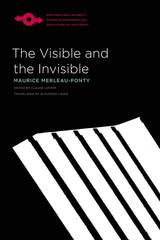
The Visible and the Invisible
Maurice Merleau-Ponty
Northwestern University Press, 1968
The Visible and the Invisible contains the unfinished manuscript and working notes of the book Merleau-Ponty was writing when he died. The text is devoted to a critical examination of Kantian, Husserlian, Bergsonian, and Sartrean method, followed by the extraordinary "The Intertwining–The Chiasm," that reveals the central pattern of Merleau-Ponty's own thought. The working notes for the book provide the reader with a truly exciting insight into the mind of the philosopher at work as he refines and develops new pivotal concepts.
[more]

Visible!
Attracting Customers in a Distracted World
Oliver Pott and Jan Bargfrede
Campus Verlag, 2023
A strategy guide for finding customers for your business in a distracted digital world.
The internet has fundamentally changed how businesses reach their customers. Whereas historically it took a major, expensive marketing campaign to get the attention of potential customers, now digital visibility offers similar results on a much more modest budget. Visible! illustrates how by deploying the concept of “smart visibility” to show businesses and entrepreneurs how to more easily find their audience and build a brand.
The internet has fundamentally changed how businesses reach their customers. Whereas historically it took a major, expensive marketing campaign to get the attention of potential customers, now digital visibility offers similar results on a much more modest budget. Visible! illustrates how by deploying the concept of “smart visibility” to show businesses and entrepreneurs how to more easily find their audience and build a brand.
[more]
READERS
Browse our collection.
PUBLISHERS
See BiblioVault's publisher services.
STUDENT SERVICES
Files for college accessibility offices.
UChicago Accessibility Resources
home | accessibility | search | about | contact us
BiblioVault ® 2001 - 2024
The University of Chicago Press









